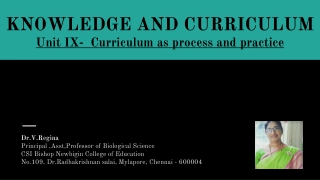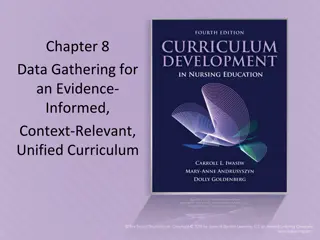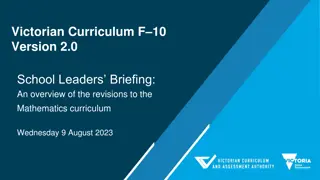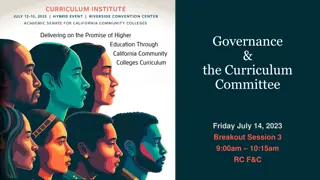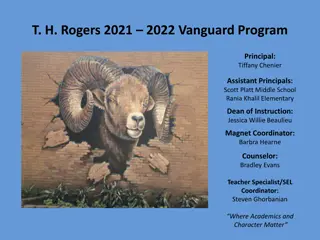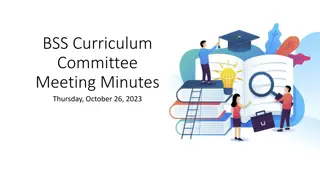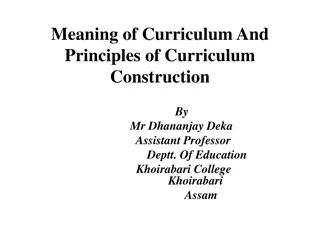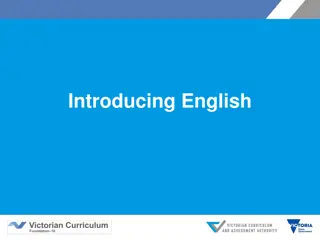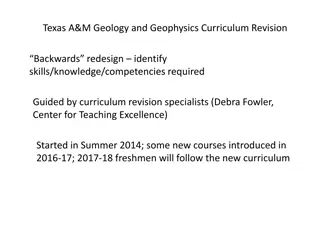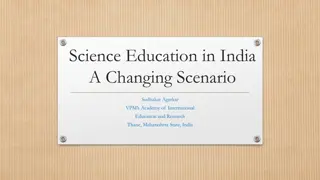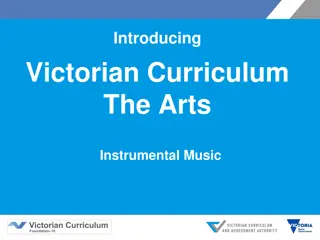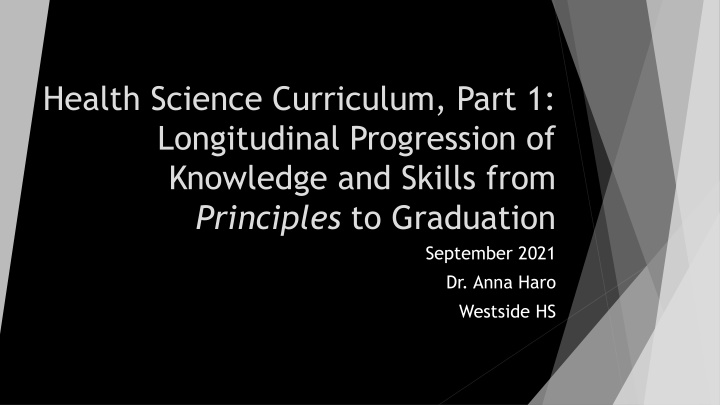
Health Science Technology Curriculum Progression
Explore the longitudinal progression of knowledge and skills in the Health Science Technology program, comparing TEKS with certification exam competencies. Discuss course offerings, student goals, and curriculum alignment for HST students.
Download Presentation

Please find below an Image/Link to download the presentation.
The content on the website is provided AS IS for your information and personal use only. It may not be sold, licensed, or shared on other websites without obtaining consent from the author. If you encounter any issues during the download, it is possible that the publisher has removed the file from their server.
You are allowed to download the files provided on this website for personal or commercial use, subject to the condition that they are used lawfully. All files are the property of their respective owners.
The content on the website is provided AS IS for your information and personal use only. It may not be sold, licensed, or shared on other websites without obtaining consent from the author.
E N D
Presentation Transcript
Health Science Curriculum, Part 1: Longitudinal Progression of Knowledge and Skills from Principles to Graduation September 2021 Dr. Anna Haro Westside HS
LEARNING OBJECTIVES Participants will evaluate the progression of TEA courses in the Health Science Technology (HST) program of study. Participants will compare TEKS from HST courses with the knowledge competencies on the Pharmacy Technician Certification Exams. Participants will align and develop HST course assessment activities with TEKS and certification exam competencies.
Objetivos de aprendizaje . Los participantes evaluar n m ltiples progresiones de cursos de TEA en el programa de estudio de Tecnolog a de Ciencias de la Salud (HST). Los participantes comparar n los TEKS de los cursos HST con las competencias de conocimiento en los Ex menes de Certificaci n de T cnico de Farmacia. Los participantes alinear n y desarrollar n las actividades de evaluaci n del curso HST con las competencias de los ex menes de certificaci n y TEKS.
Getting to know each other Type your campus name and current course(s) in the TEAMs chat. My background in health care and education How many years have you taught in public schools? And how many in HISD? Do you have any personal learning goals for attending today s PD session? Or are you just looking for the hours?
Contact info Please, feel free to reach out to me at any time. My contact info Email: Anna.Haro@Houstonisd.org Remind: text the code @HaroPLC to the number 81010 MS TEAMs: use the HISD TEAM chat to send me a message. Website: https://www.houstonisd.org/Domain/52335
HST program courses Currently, the Texas Education Agency offers thirteen (13) different TEKS-based courses in Health Science Technology (HST). TEKS Chapter 130, Subchapter H Schools can choose from the thirteen offerings, starting with Principles of Health Science then progressing through many options culminating in their Senior year. Discuss: what level- 4 course(s) is(are) offered for your seniors at your campus? Ideally, students begin their HST program as freshmen then continue through the curriculum in a progressive and longitudinal pattern. Discuss: what is the goal for the HST students at your campus?
Level One Level Two/Three Level Two/Three/Four Level Three/Four HST Curriculum Progression (current courses) Principles of Health Science (pre-reqs = Bio and another HS Science) Anatomy & Physiology Health Science Theory (pre-req = Bio) World Health Research (pre-req = Bio and Chem) or Medical Terminology Medical Microbiology (pre-reqs = Bio and Chem) Health Science Clinical (pre-req = Bio and co-req = Health Sci Theory) Pathophysiology (pre-reqs = Bio and Chem) No Pre- requisites At least 2 pre- requisites required Note: Pre-requisite and applicable required co- requisite. Health Informatics (pre-reqs = Business Info Mgmt and MT) Mathematics for Health Profs (pre-reqs = Algebra and Geometry) Pharmacology (pre-reqs = Bio and Chem) Practicum in Health Science (pre-reqs = Bio and Health Sci Theory) Link: https://texreg.sos.state.tx.us/publi c/readtac$ext.ViewTAC?tac_view=5 &ti=19&pt=2&ch=130&sch=H&rl=Y Extended Practicum in Health Science (pre- reqs = Bio, Health Sci Theory, and co-req = Practicum in Health Sci)
HST program courses Additionally, there are 23 TEA-approved innovative courses in the HST program including titles such as Science of Nursing, Principles of Therapeutic Healthcare, Pharmacy 1, Clinical Ethics, Dental Anatomy and Physiology and more. TEA Innovative Courses in HST Finally, there are about a dozen HST courses in consideration by the Texas State Board of Education, including Medical Assistant and Pharmacy 2. Discuss: what are the benefits/burdens of more course offerings?
What is the correct progression of courses to Graduation? The progression of classes depends on your program goals and individual student goals. Texas Education Agency does not dictate the specific courses nor the progression (except for course pre- requisites and co-requisites) of courses to complete the Public Service (HST) diploma endorsement. Texas Education Agency does not require specific courses in the HST program to complete the qualifications to sit for an industry-based certification exam. Discuss: What industry certification exams do you offer or plan to offer to your students?
Principles TEKS aligned to CPhT 130.222(c)(2) The student applies mathematics, science, English language arts in health science to (A) convert units between systems of measurement; (B) apply data (C) interpret technical material related to the health science industry (E) plan and prepare effective oral presentations. 130.222(c)(9) The student interprets ethical behavior standards and legal responsibilities to: (E) research laws governing the health science industry. 130.222(c)(10) The student recognizes the importance of maintaining a safe environment and eliminating hazardous situations to: (B) identify safety standards and (C) relate safety practices in the health science industry.
Medical Terminology TEKS aligned to CPhT 130.223(c)(4) The student examines available resources to (B) integrate resources to interpret technical materials; and (C) investigate electronic media with appropriate supervision. (Note: use the HON-code criteria) 130.223(c)(2) The student recognizes the terminology related to the health science industry to: (A) identify abbreviations, acronyms, and symbols related to the health science industry; (B) identify the basic structure of medical words and (G) use prior knowledge and experiences to understand the meaning of terms as they relate to the health science industry. 130.223(c)(6) The student appropriately translates health science industry terms to: (A) interpret, transcribe, and communicate vocabulary related to the health science industry; (B) translate medical terms to conversational language to facilitate communication; (C) distinguish medical terminology associated with medical specialists and (E) interpret contents of medical scenarios correctly.
Health Science Theory TEKS aligned to CPhT 130.231(c)(9) The student implements the knowledge and skills of a health science professional in the classroom setting to (A) comply with specific industry standards related to safety and substance abuse (C) articulate comprehension of assignment; (D) employ medical vocabulary specific to the health care setting (G) role play techniques used in stressful situations and (I) perform skills specific to a health care science professional such as pharmacy technician. 130.231(c)(11) The student exhibits the leadership skills necessary to function in a democratic society to: (A) identify leadership skills of health science professionals; (B) participate in group dynamics; and (C) integrate consensus building techniques. Others: 130.231(c)(10) = ethics and law, (12) = safety, (13) = wellness and disease prevention
Pharmacology TEKS aligned to CPhT 130.230(c)(2) The student explores the filed of pharmacology and foundation of pharmacology to (A) define pharmacology and its major subdivisions (B) explain the difference between therapeutic effects, side effects, and toxic effects; (C) identify a drug receptor in the human body; (D) trace the interaction and antagonist receptor; (E) explain the relationship among drug dosage, drug response, and time; (F) explain drug safety and therapeutic index; (G) describe [two] names [and drug classification] by which drugs are known; and (H) list [and utilize] two common drug reference books. 130.230(c)(4) The student explains the ethical and legal responsibilities of pharmacists and pharmacy technicians to: (A) describe prescription errors; (B) differentiate between negligence, product liability, contributory negligence, and regulatory law; (C) evaluate the effect of medication errors and (E) define professional liability. Others: 130.230(c)(6) = mathematics and pharmacy calculations, (7) = pharmaceutics and dosage forms (9) = safety
Pharmacy Technician Competency Domains Note: There are two Pharmacy Technician Certification Exams, PTCB and ExCPT (***exceptions: WY, ND, and LA) Most pharmacies prefer PTCB, but the Texas State Board of Pharmacy recognizes both. However, the current state of technician shortages is creating desperate situations nationwide, including I will hire anyone with a pulse and if I get an occasional smile, that s just a bonus. From Appendix C: PTCE content outline - Medications, Federal Requirements, Patient Safety and Quality Assurance, and Order Entry and Processing From NHAnow blog, ExCPT competencies: Overview and Laws, Drugs and Drug Therapy, Dispensing Process, and Medication Safety and Quality Assurance
Assessment Activities that align with TEKS Creating/Presenting Drug Flash Cards, Creating a drug commercial, Matching games with drug classes Pharmacy Calculations and dosing problems Interpreting sig codes, reading sample RXs Law timelines and interpreting laws from case scenarios Red Flags mock scenarios and safety interventions On-Track exams, MS Forms quizzes, Quizlet, fill-in-the blank SOAP Notes Official PTCB practice exam ($19 for educator programs) NHAnow prep program ($289 for online training program) including 20 learning modules and 3 different practice tests
Whats Next? Current barriers for technician training: COVID, curriculum, texts, vendors, affiliations agreements, age restrictions and more. Discuss: what barriers do you face or do you anticipate? You are encouraged to attend the next PD session from 2:30 to 3:30 PM to discuss the training skills gaps, opportunities, and challenges.
Questions about the HST Curriculum Progression from Principles to Graduation? I don t have most of the answers, but I can help find the right references and can develop a PLC for our curriculum and instructional needs. Anna.Haro@HoustonISD.org Text @HaroPLC to 81010 https://www.houstonisd.org/Domain/52335
References https://texreg.sos.state.tx.us/public/readtac$ext.ViewTAC?tac_vie w=5&ti=19&pt=2&ch=130&sch=H&rl=Y, accessed 15 Sep 2021. https://tea.texas.gov/sites/default/files/130H- Health%20Sci%20tc.pdf accessed 15 Sep 2021. https://tea.texas.gov/academics/learning-support-and- programs/innovative-courses/innovative-courses-career-and- technical-education, accessed 15 Sep 2021. https://www.ptcb.org/guidebook/ptce-content-outline, accessed 16 Sep 2021. https://www.ptcb.org/guidebook/ptce-content-outline, accessed 16 Sep 2021. https://info.nhanow.com/blog/the-excpt-exam-what-to-expect- and-how-to-prepare, accessed 16 Sep 2021. 1. 2. 3. 4. 5. 6.

